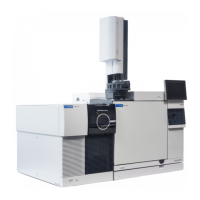6 Operating in CI Mode
Carbon Dioxide CI
134 7000/7010 Series TQ GC/MS Operating Manual
Ammonia CI
Ammonia (NH
3
) is commonly used for CI when less fragmentation is desired in
the CI spectrum. This is because the proton affinity of ammonia is higher than
that of methane; hence less energy is transferred in the ionization reaction.
Because many compounds of interest have insufficient proton affinities,
ammonia CI spectra often result from the addition of NH
4
+
and then, in some
cases, from the subsequent loss of water. Ammonia reagent ion spectra have
principal ions at m/z 18, 35, and 52, corresponding to NH
4
+
, NH
4
(NH
3
)
+
, and
NH
4
(NH
3
)
2
+
.
Ammonia tends to break down vacuum pump fluids and seals. Ammonia CI
makes more frequent vacuum system maintenance necessary. Refer to the
7000/7010 Series Triple Quad GC/MS Troubleshooting and Maintenance Manual.
Frequently, a mixture of 5% ammonia and 95% helium or 5% ammonia and 95%
methane is used as a CI reagent gas. This is enough ammonia to achieve good
CI while minimizing its negative effects.
Carbon Dioxide CI
Carbon dioxide is often used as a reagent gas for CI. It has obvious advantages
of availability and safety.
Use of ammonia affects the maintenance requirements of the MS. (See
Chapter 7, “General Maintenance,” starting on page 147 for more information.)
The pressure of the ammonia supply must be less than 5 psig. Higher
pressures can result in ammonia condensing from a gas to a liquid.
Always keep the ammonia tank in an upright position, below the level of the
flow module. Coil the ammonia supply tubing into several vertical loops by
wrapping the tubing around a can or bottle. This will help keep any liquid
ammonia out of the flow module.
When running ammonia for 5 or more hours a day, the foreline pump must be
ballasted (flushed with air) for at least 1 hour a day to minimize damage to
pump seals. Always purge the MS with methane after flowing ammonia.

